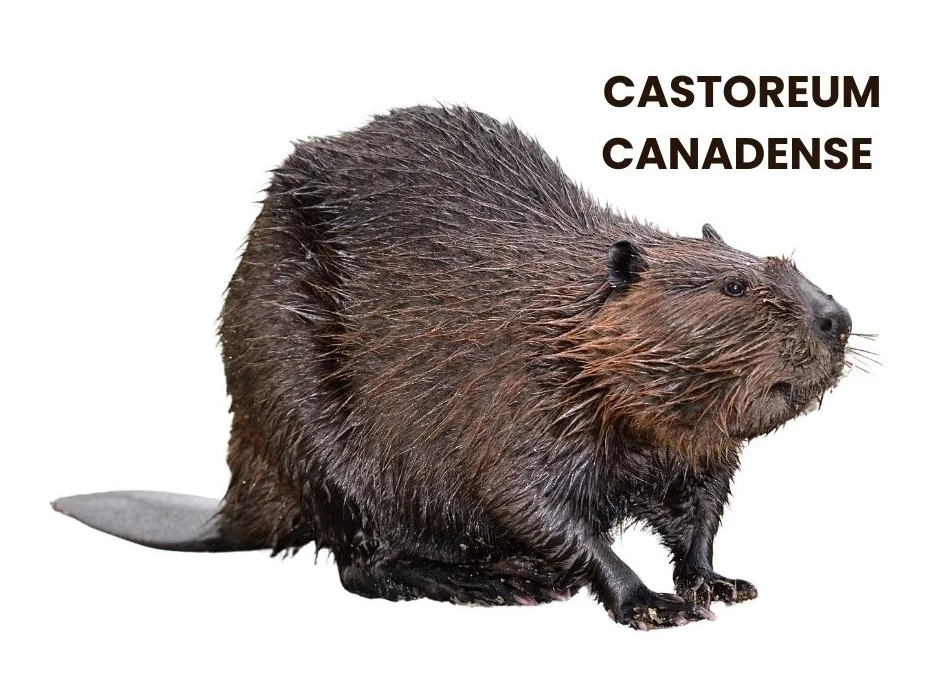Castoreum Canadense, derived from the beaver, is a prominent homeopathic remedy primarily indicated for hysteria and related nervous symptoms.
It is especially beneficial for individuals experiencing marked prostration and debilitating sweats, often associated with hysterical manifestations and other nervous complaints.

Table of Contents
ToggleSOURCE INFORMATION
Scientific Classification
- Kingdom: Animalia
- Phylum: Chordata
- Class: Mammalia
- Order: Rodentia
- Family: Castoridae
- Genus: Castor
- Species: Castor canadensis
Origin
- Castoreum Canadense, commonly known as the beaver, is a homeopathic remedy sourced from the glandular secretion of the North American beaver, Castor canadensis.
- Beavers are large, semi-aquatic rodents native to North America, particularly prevalent in regions with freshwater bodies such as rivers, streams, and lakes.
- The secretion used for preparing Castoreum Canadense is obtained from the castor sacs, located near the anus of the beaver. These sacs produce a substance known as castoreum, which the beavers use for territorial marking and communication.
Historical Background
- The medicinal use of castoreum dates back centuries and has been documented in various traditional healing systems, including Native American and early European medicine.
- Native American tribes such as the Iroquois and Algonquin utilized castoreum for its purported medicinal properties, employing it to treat ailments ranging from headaches to menstrual disorders.
- In European herbal medicine, castoreum was valued for its stimulant, analgesic, and antipyretic properties, often prescribed as a remedy for nervous disorders, fevers, and respiratory ailments.
Therapeutic Reputation
- Castoreum Canadense has a long-standing reputation in homeopathy for its efficacy in treating hysterical symptoms, marked prostration, and nervous affections.
- It is indicated for individuals, particularly women, experiencing debilitating sweats, restlessness, and nervous irritability.
- The remedy is also beneficial for addressing menstrual disorders such as dysmenorrhoea and amenorrhoea, along with certain fever symptoms characterized by chilliness and coldness in the back.
Preparation Method
- To prepare Castoreum Canadense for homeopathic use, the secretion obtained from the castor sacs of the beaver is diluted and succussed according to the principles of homeopathic pharmacy.
- The resulting tincture or potency is then prescribed based on the individual’s symptomatology and case presentation.
KEY CHARACTERISTICS
Hysteria: Castoreum is renowned for its efficacy in addressing hysteria, with symptoms of marked prostration and nervousness.
Day-blindness: Patients may experience day-blindness and an inability to endure light, indicating sensitivity to bright light.
Nervous Symptoms in Women: Particularly indicated for nervous women who do not fully recover, remain irritable, and suffer from debilitating sweats.
Spasmodic Affections: Effective for spasmodic affections following debilitating diseases, characterized by constant yawning and restless sleep with frightful dreams and starts.
Tongue Symptoms: Tongue may exhibit swelling and a rounded elevation in the center, accompanied by a drawing sensation from the center to the hyoid bone.
Female Symptoms
- Dysmenorrhoea: Painful menstruation with blood discharged in drops and accompanied by tenesmus. Pain often starts in the middle of the thighs.
- Amenorrhoea: Absence of menstruation, accompanied by painful tympanites (abdominal distension).
Fever Symptoms: Patients may experience predominant chilliness and attacks of chilliness with ice-coldness in the back.
MODALITIES
Symptoms may be aggravated or ameliorated by various factors, which can be explored through individual case analysis.
WHAT ARE MODALITIES IN HOMOEOPATHY?
RELATIONSHIP WITH OTHER REMEDIES
Castoreum Canadense shares similarities with other remedies such as Ambra, Moschus, Mur acid, and Valeriana in certain symptom presentations, indicating possible complementary or alternative treatment options.
Antidote
Colchicum is listed as an antidote to Castoreum Canadense, suggesting its potential use in cases of remedy overdose or adverse reactions.
DOSE
Castoreum Canadense is typically administered in tincture form and lower potencies, as per standard homeopathic prescribing practices.
Frequently Asked Questions
What is Castoreum Canadense used for?
- Castoreum Canadense is primarily used for hysteria and related symptoms, including prostration, day-blindness, debilitating sweats, spasmodic affections, constant yawning, and restless sleep with frightful dreams.
How is Castoreum Canadense prepared?
- Castoreum Canadense is prepared from the secretions of the beaver and undergoes the standard homeopathic preparation process to create potentized remedies used in homeopathic practice.
What are the common symptoms indicating the need for Castoreum Canadense?
- Common symptoms include marked prostration, hysteria, day-blindness, intolerance to light, irritability, debilitating sweats, spasmodic affections following debilitating diseases, constant yawning, and dysmenorrhoea with tenesmus.
Is Castoreum Canadense safe for self-administration?
- Like all homeopathic remedies, Castoreum Canadense should be used under the guidance of a qualified homeopathic practitioner.
- It is important to ensure proper dosage and individualized prescribing to achieve optimal results and avoid any adverse effects.
Meaning of Difficult Words
- Hysteria: A psychological disorder characterized by emotional instability, irrational behavior, and physical symptoms such as hysteria and fainting.
- Prostration: Extreme physical or mental weakness or exhaustion.
- Tenesmus: Painful straining to pass stools or urine.
- Predominant: Having greater importance, influence, or strength.
- Debilitating: Causing weakness or impairment.
- Antidote: A substance that counteracts the effects of another substance.













Leave a Reply